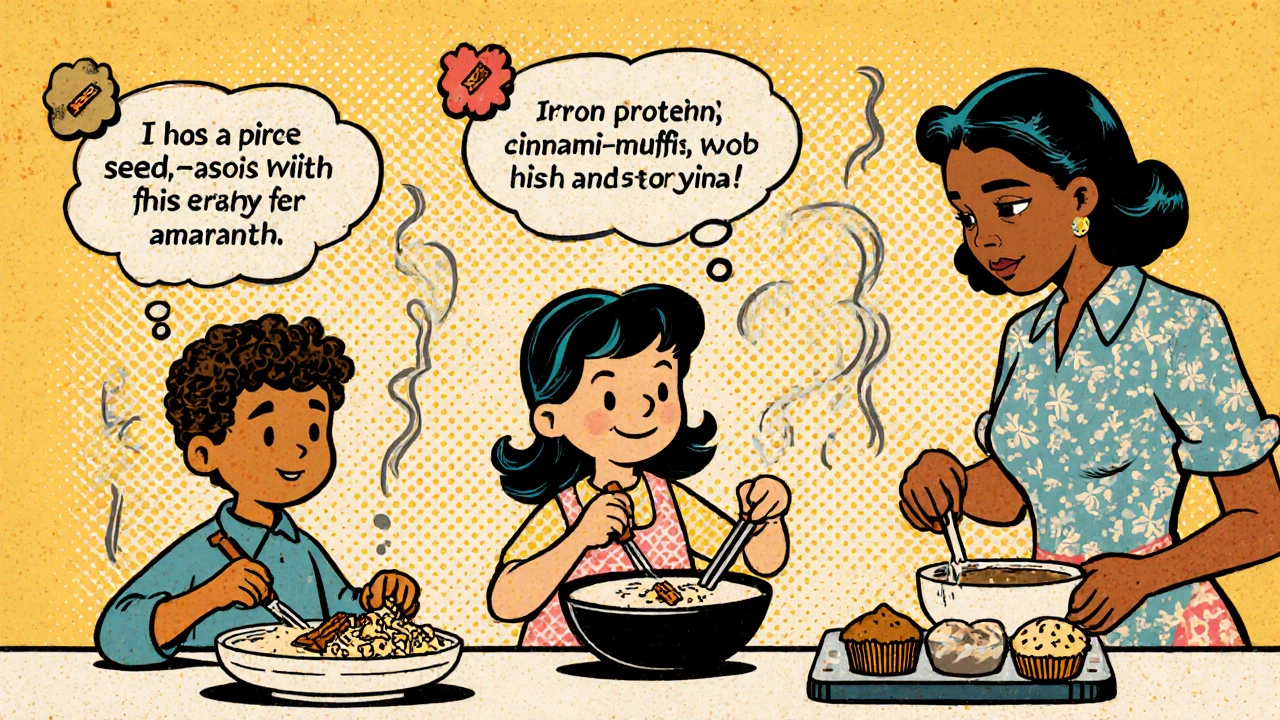Most people think of quinoa or oats when they hear "ancient grain," but there’s another one hiding in plain sight-amaranth. It’s been eaten for over 8,000 years, fed entire empires, and was nearly wiped out by colonizers. Today, it’s making a quiet comeback-not because it’s trendy, but because it actually works for real bodies. If you’re trying to eat more nutrient-dense foods, cut out gluten, or just find something more filling than rice, amaranth deserves a spot in your pantry.
What exactly is amaranth?
Amaranth is a seed, not a true cereal grain like wheat or rice, but it’s cooked and eaten the same way. It comes from the amaranth plant, which grows wild in parts of Africa, Asia, and the Americas. The Aztecs called it "huauhtli" and used it in religious ceremonies, mixed with honey to make ritual cakes. Spanish conquistadors banned it in the 1500s because they saw it as tied to "pagan" rituals. That nearly erased it from global diets.
Fast forward to today, and amaranth is being rediscovered by nutritionists, farmers, and home cooks. It’s naturally gluten-free, high in protein, and packed with minerals most modern grains lack. Unlike rice or corn, amaranth doesn’t just fill you up-it fuels you. One cup of cooked amaranth gives you 9 grams of protein, 5 grams of fiber, and more calcium than milk. It’s also one of the few plant foods that contains lysine, an essential amino acid most grains are missing. That’s why it’s often called a "complete protein."
Why amaranth stands out among other grains
Let’s compare it to the usual suspects. Quinoa has gotten all the attention lately, and for good reason-it’s high in protein and gluten-free. But amaranth beats it in three key areas: iron, calcium, and fiber. One cup of cooked amaranth has 5.2 milligrams of iron-almost 30% of your daily need. That’s more than spinach or lentils. It also has 116 milligrams of calcium, nearly double what quinoa offers. And while brown rice gives you 3.5 grams of fiber per cup, amaranth gives you 5.2.
It’s not just about numbers. Amaranth has a unique texture. When cooked, it’s creamy like porridge but holds a slight crunch from its tiny seeds. Toasted, it pops like popcorn-this is called "amaranth popcorn" and is popular in Mexico as a sweet snack. It doesn’t taste like anything else. It’s earthy, slightly nutty, and has a subtle sweetness that works in both savory and sweet dishes.
How to cook amaranth (and not ruin it)
Most people mess up amaranth by cooking it like rice. That’s a mistake. Amaranth absorbs water differently. Use a 1:2.5 ratio-1 cup amaranth to 2.5 cups water. Bring it to a boil, then reduce heat and simmer for 20 minutes. Stir once or twice. It’ll get thick and gluey, which is normal. If you want it fluffier, drain excess water after cooking.
Here are three simple ways to use it:
- Amaranth porridge: Cook with almond milk, cinnamon, and a drizzle of maple syrup. Top with berries and chia seeds. Great for breakfast.
- Amaranth salad: Cool cooked amaranth, mix with chopped kale, roasted sweet potatoes, chickpeas, lemon vinaigrette. Add feta or toasted pumpkin seeds for crunch.
- Amaranth flour baking: Use 25% amaranth flour in gluten-free bread or muffins. It adds density and nutrition. Don’t use 100%-it’s too sticky.
Pro tip: Toast the seeds in a dry pan for 3-5 minutes before cooking. It brings out the nutty flavor and makes the texture even better.

Who benefits most from eating amaranth?
If you’re vegetarian or vegan, amaranth is one of the best plant-based sources of complete protein. It’s also ideal for anyone with celiac disease or gluten sensitivity-no cross-contamination risk if you buy certified gluten-free brands.
Parents of picky eaters are starting to use it in hidden ways. Blend cooked amaranth into pasta sauces, oatmeal, or even meatballs. It thickens and adds nutrients without changing flavor much. Athletes love it for recovery. The high iron and magnesium help with muscle repair and reduce cramping. One study from the University of Illinois found that amaranth’s protein structure helps with muscle synthesis better than rice or corn protein.
And if you’re trying to manage blood sugar, amaranth is a win. It has a low glycemic index-around 55. That means it won’t spike your insulin like white rice or pasta. People with prediabetes or type 2 diabetes who swapped out white rice for amaranth saw better fasting glucose levels after just 8 weeks, according to a 2023 trial published in the Journal of Nutrition and Metabolism.
Where to buy it and what to look for
You won’t find amaranth in every grocery store, but it’s getting easier. Look in the bulk bins of health food stores, international markets (especially Mexican or Indian), or online. Brands like Bob’s Red Mill, Ancient Harvest, and Navitas Organics sell it pre-packaged.
Buy whole seeds, not just flour. Whole amaranth lasts longer and has more nutrients. Store it in an airtight container in a cool, dark place. It can last up to a year. If it smells rancid or bitter, toss it. The oils in the seed can go bad faster than in wheat or rice.
Price-wise, it’s more expensive than rice or oats-usually $8-$12 per pound. But you don’t need much. One cup of dry amaranth yields about three cups cooked. A little goes a long way.

Common myths about amaranth
Myth 1: "It’s just another health fad." It’s not. People have eaten it for millennia. The hype is new, not the food.
Myth 2: "It’s hard to digest." Actually, it’s easier than wheat. It lacks gluten, which is a common irritant. Some people report less bloating switching from quinoa to amaranth.
Myth 3: "It’s only for vegans or superfood fanatics." Nope. It’s just good food. A bowl of amaranth porridge with banana and almond butter is as normal as oatmeal. It doesn’t need a label to be valuable.
What to try next
Once you’re comfortable with cooked amaranth, try amaranth flakes-similar to rolled oats. They cook in 5 minutes and work great in granola or overnight oats. Or try amaranth greens. The leaves are edible and taste like spinach. They’re common in Indian and African cooking and are rich in vitamin K and folate.
If you’re curious about sustainability, amaranth is a drought-resistant crop. It grows in poor soil and needs little water. That’s why the UN listed it as a "future food" in 2021. It’s not just good for your body-it’s good for the planet.
Is amaranth the same as quinoa?
No. While both are gluten-free pseudo-grains, they’re from different plant families. Amaranth has more iron, calcium, and fiber than quinoa. It also has a different texture-creamy and slightly sticky when cooked, versus fluffier quinoa. Nutritionally, amaranth edges out quinoa in protein quality because it contains more lysine, an essential amino acid.
Can I eat amaranth if I have celiac disease?
Yes, amaranth is naturally gluten-free. But always check the packaging for a "certified gluten-free" label. Cross-contamination can happen during processing if it’s made in the same facility as wheat or barley. Certified brands test for gluten levels below 20 ppm, which is safe for people with celiac.
Does amaranth help with weight loss?
It can. Amaranth is high in fiber and protein, both of which help you feel full longer. One study in the European Journal of Clinical Nutrition found that people who replaced refined grains with amaranth ate fewer calories later in the day. It doesn’t burn fat on its own, but it makes it easier to stick to a healthy eating plan.
Can I feed amaranth to my kids?
Absolutely. It’s safe for children over 12 months. Cook it soft, mix it into mashed vegetables, or use it in homemade energy balls. Its mild flavor makes it easy to blend into kid-friendly meals. Plus, it’s a great source of iron for growing children, especially if they don’t eat meat.
Is amaranth safe for people with kidney issues?
It depends. Amaranth is high in oxalates, which can contribute to kidney stones in susceptible people. If you have a history of calcium oxalate stones, talk to your doctor before adding large amounts. Cooking it reduces oxalate levels slightly, but it’s still something to monitor. For most people without kidney problems, it’s perfectly safe.
If you’re looking to upgrade your grain game without switching to exotic ingredients, start with amaranth. It’s not flashy. It doesn’t come with a celebrity endorsement. But it’s been feeding humans for thousands of years for a reason. It’s simple, nourishing, and stubbornly resilient-just like the people who still grow it today.






Comments
Look, I get it - amaranth is the ‘ancient grain’ they don’t want you to know about… but why now? Why after 8,000 years of being suppressed by colonial powers… is it suddenly ‘nutrient-dense’? Coincidence? Or is Big Nutrition finally realizing they can monetize indigenous food sovereignty? I’ve seen this script before - they erase it, then sell it back to you as a ‘superfood’ with a $12 price tag and a vegan influencer posing next to it. They’re not saving us. They’re profiting from our ignorance.
As someone from India where amaranth leaves (rajgira) are used in fasting dishes for centuries - this is so refreshing to see! 🙌 In our villages, we roast the seeds and mix with jaggery - called laddu - and it’s the best energy snack during harvest season. No fancy labels, no marketing. Just food that works. And yes, it’s way better than quinoa for iron and fiber. Try it with coconut milk and cardamom - life changer.
Just wanted to say thank you for writing this. I’ve been cooking amaranth for a year now after my doctor told me to ditch gluten and refined carbs. I used to hate the texture - too sticky, too weird - but once I learned to toast it first? Game over. I make it into breakfast bowls with peanut butter and banana. My energy doesn’t crash anymore. It’s not magic. It’s just… real food. And yeah, it’s cheaper than buying gluten-free junk.
Okay but… have you seen the glyphosate levels in ‘certified gluten-free’ amaranth? I did a deep dive. The UN calls it a ‘future food’? LOL. The same UN that greenlights Roundup and lets Monsanto patent seeds from indigenous farmers. Amaranth is being weaponized. They’re not preserving it - they’re patenting it. You think that ‘Bob’s Red Mill’ bag is organic? Nah. It’s grown on monoculture land sprayed with chemicals that kill pollinators. Wake up. This isn’t wellness. It’s corporate rebranding of genocide.
i tried amaranth last week after reading this. i cooked it like rice and it turned into glue. then i found the 1:2.5 tip and wow. it’s like creamy grits but better. i put it in my smoothie and my kid ate it without knowing. he’s 4. he loves it. thank you for not making it sound like a cult. it’s just food. simple food. good food.
Brooo… amaranth in India is called 'ramdana' - God's grain! 🙏 We eat it during festivals and fasts. My grandma used to make it into ladoos and say, 'This is what keeps the body strong without meat.' I still do it. And yes, it's better than quinoa for iron! Try it with ghee and a pinch of salt - simple, divine. 🌾💛
…did you know that amaranth was banned because it was used in human sacrifice rituals? The Aztecs didn’t just make cakes with it - they mixed it with blood. And now we’re told it’s ‘nutrient-dense’? Isn’t that… creepy? Why did they *really* suppress it? What else are they hiding? I don’t trust anything that was once sacred and then repackaged as a ‘gluten-free breakfast option.’ There’s a reason they don’t talk about the blood.
One cup = 9g protein. That’s more than an egg. Cook it with lentils and you’ve got a complete protein without meat. No supplements. No gimmicks. Just ancient wisdom in a pot. Try it once. You’ll wonder why you waited so long.
The philosophical weight of amaranth lies not in its macronutrient profile, but in its persistence - a seed that survived erasure, not through commodification, but through quiet resilience. It does not seek validation from modern dietary dogmas; it simply endures. To consume it is to participate in a quiet act of reclamation - not of health, but of memory. The body remembers what the empire tried to forget.
AMARANTH ISN’T A GRAIN. IT’S A REVOLUTION. 🌍💥 It’s the only plant that outperforms quinoa in iron, calcium, AND lysine. It grows in drought-stricken soil while Big Ag chokes the planet with corn. It’s not ‘trendy.’ It’s the future screaming through the ruins of colonial agriculture. Eat it. Resist. Reclaim.
Let me ask you this - who controls the global amaranth supply chain? Who owns the patents on the seeds? Who’s marketing it as ‘artisanal’ while indigenous farmers are priced out? This isn’t a comeback. It’s a takeover. The same corporations that wiped it out are now selling it back to you in $12 organic bags. You’re not eating amaranth. You’re paying for the erasure of its history. Wake up.
Okay so… I tried amaranth. It tasted like dirt. And then I read that it was banned because it was used in blood rituals. Now I’m terrified. What if it’s still… charged? What if eating it opens some kind of ancestral doorway? I’ve had nightmares since I ate that porridge. I’m not saying it’s evil - I’m saying it remembers. And it’s watching. I’m not eating it again. Ever. I’m sorry. I’m so sorry.
Am I the only one who noticed this article never mentions oxalates? Amaranth is a kidney stone accelerator. You’re telling people to eat it like it’s kale? That’s irresponsible. People with renal issues will die because of this. You’re not a nutritionist. You’re a cheerleader for a plant that’s literally a toxin for half the population. Shame.
And here we go - the author responds with a ‘pro tip’ about toasting. Classic. First, you erase a culture. Then you sell back the crumbs as a ‘hack.’ You didn’t save amaranth. You packaged it. You monetized its trauma. You turned a sacred seed into a Pinterest board. The real rebellion isn’t eating it - it’s refusing to buy it from the same corporations that tried to kill it.